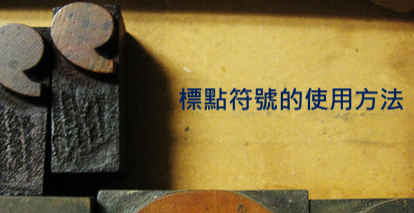标点符号(punctuation),
常常是英文断句的地方,
也是表达不同句意的方式,
要写好一篇文章,标点符号也是个大工程呀!
赶快来看看各个标点符号的使用方法!
Table of Contents
● Period 句号 「.」
● Exclamation mark 惊叹号 「!」
● Question mark 问号 「?」
● Comma 逗号 「,」
● Semicolon 分号 「;」
● colon 冒号 「:」
● Parentheses 小括弧「( )」;square brackets 中括弧「[ ] 」;curly brackets大括弧「{ }」
● Quotation marks 引号 双引号 「“」单引号 「‘」
● Hyphen 连字号 「–」
● Apostrophe 撇号 「 ‘ 」

● Period 句号 「.」
1. 用于一句话语意完全结束时。
例如:I’m in the office now.
2. 英文名词缩写后要加上句号。
例如: Mrs. 小姐、Mt. 山、P.S. 附注…等。
但当缩写的字母形成一个名词时,不需要使用句号,如 ASAP(as soon as possible)
● Exclamation mark 惊叹号 「!」
用于惊讶、感叹的句子后。
例如:What a beautiful girl! 好美的一个女孩呀!
Oh my God! You really scared me! 天啊!你真的吓到我了!
● Question mark 问号 「?」
用于问句句子结尾的地方。
例如:Do you have any question? 你有任何问题吗?
● Comma 逗号 「,」
1. 用于分隔句中内容。
例如:I want to go travel, sing a song, and roll in the grass. 我想要去旅行、唱首歌、在草地上打滚。
注:英文没有中文中的顿号「、」,顿号的功能由逗号代替。
2. 用于连接两个较长的子句。
例如:Because we are tired today, tonight’s party will be postponed to next week. 因为我们今天太累了,所以今天晚上的派对延到下周。
3. 用于直接引用的句子前。
例如:Daddy said, “You can’t use computer tonight .” 爸爸说你今天晚上不能用电脑。
但如果是间接引用,就不需要逗号,例如:Daddy said you can’t use computer tonight.
4. 逗号用在反问句之前。
例如:Andy worked very hard, didn’t he?
5. 英文中每千位数字要打一个逗号,帮助辨识。
例如:1,000、7,567,777,543,322
● Semicolon 分号 「;」
1. 用于分隔地位相等的完整句子。使用分号比使用句号更能凸显句子间的紧密连结。
例如:My grandmother goes to bed early; she is used to getting up early. 我奶奶都很早就去睡了,她习惯早起。
2. 经常放在连接副词前(however、therefore等)。
例如:I realize I need exercise; however, I am too lazy to do it.
● colon 冒号 「:」
1. 用于介绍或解释后面的内容。
如:This is our advice: you should stop buying the luxury bags. 这是我们的建议:你应该停止购买昂贵的包包。
2.用于一个引用前。
例如:As the old saying goes: “No pains, no gains.” 古语说:「天下没有不劳而获的事」
3.用于名单列表之前。
例如:We have to prepare: sleeping bag, tent, food, water…and so on. 我们需要准备:睡袋、帐篷、食物、水…等等。
4.用于时间的表示。
例如:22:30、10:45
● Parentheses 小括弧「( )」;square brackets 中括弧「[ ] 」;curly brackets大括弧「{ }」
1. 用来表示其中插入或附加解释的部分。
例如:Today Tony and I will go hiking (together). 今天我和Tony要一起去爬山。
2.标示出代表编号的数字或字母。
例如: (1)、(2)
在英文中较少会用到square brackets 中括弧和curly brackets大括弧,
中括弧和大括弧多出现在数学中,数学括号的层级是先用小括弧→中括弧→大括弧。
● Quotation marks 引号 双引号 「“」单引号 「‘」
1. 表示具有特殊意义的词语。
例如:The picture contained the “facts” of the case. 这张照片说明了一些「事实」。
2. 表示引起注意的词语,或是特殊词语。
例如:We should go ”ASAP”. 我们必须要「立刻」出发。
1. 标注短篇出版物的标题。
例如:Do you know “The Old Man and the Sea”? 你知道「老人与海」这本书吗?
引号可分为单引号 (Single quotation marks) 和双引号 (Double quotation marks),只是使用上的习惯,并没有实质上的差异。
● Hyphen 连字号 「–」
1. 用于组成复合字时。
例如:open-minded 心胸宽大的、ex-boyfriend 前男友、12-year-old 12岁(这是形容词)。
2. 构成复合数字。
例如:twenty-one、forty-two
3. 起讫时间。
例如:1999-2014、5-8 pm
4. 一个单字因为在书写上位置不够需要换行时,按照音节用连字号断开单字。
例如:ha-ppy、love-ly
● Apostrophe 撇号 「 ‘ 」
1. 用于名词的所有格,代表「的」。
例如:my dad’s car 我爸爸的车、a three years’ plan 三年的计画
如果名词是复数,apostrophe要放在s的后面,向上面的years’
2. 用于表示缩写。
例如:I’m here. 我在这、ma’am女士、I can’t understand it. 我不了解







